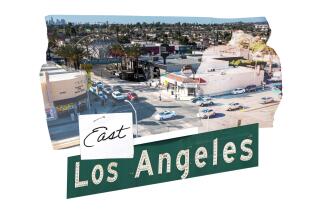Confusion Goes With 2 Westlakes’ Territory : County lines: Los Angeles has the ‘Village’ and Ventura doesn’t. One councilman says residents want the boundaries to tumble like the Berlin Wall.
- Share via
Jim Pauley has only to go in his front yard to plant a foot in Thousand Oaks and another in Westlake Village. He is used to borrowing sugar from Los Angeles County neighbors and milk from those in Ventura County.
And it’s all because his house in Westlake sits on the county line.
“I can sit in Los Angeles County and read something in Ventura,” said Pauley, 60. “If I open a window in Ventura County, I can poke a finger into L. A. Not many people can do that.”
If Pauley’s bi-county reach has become something of a household joke, some of his neighbors are sometimes frustrated by the confusing jurisdictional problems that plague this community divided between two counties.
For example, students living in the same block often attend different high schools. Those who live in Ventura County attend Westlake High School. Only a few doors away, other students are bused five miles to Agoura High School in Agoura.
Residents of this community are served by two separate fire departments, two separate sheriff’s departments and two different telephone area codes--818 and 805.
When streets crossing the county line need repair, the job requires coordination of two municipal public works crews. Even La Venta Drive, the name coined as the marriage of Los Angeles and Ventura counties, complicates repair work because it was designed by engineers from two counties.
Despite the political lines, most Westlake residents consider themselves members of one community. Given the choice, Westlake Village Councilman Ken Rufener says area residents would have the political boundary tumble like the Berlin Wall.
On the Los Angeles County side is the incorporated city of Westlake Village, a 5.4-square-mile area stretching from Decker Canyon Road to the south and Lindero Canyon Road to the north. The city counts about 11,400 residents.
In Ventura County, Westlake is actually a portion of the city of Thousand Oaks. It is bordered by Kanan Road and Lake Sherwood. Roughly 22,000 people live in this area and consider themselves Westlake residents.
In 1967, Daniel K. Ludwig’s American-Hawaiian Steamship Co. began developing 12,500 acres of ranch land into one of the nation’s first instant cities.
Architects of the master-planned city mapped a community of 70,000 people stretching from Triunfo Canyon Road in Los Angeles County to what is now Kanan Road in Ventura County.
Ludwig’s strategy was that the future city lie entirely in one county.
But neither Los Angeles County nor Ventura County would give up any territory. Thousand Oaks eventually annexed parts of the Westlake Village community.
The notion of unification was resurrected four years ago when a group of Westlake Village residents proposed carving a piece out of Los Angeles and Ventura counties and creating a new county that would extend from Calabasas to the Conejo Grade, north to Simi Valley and south to the Santa Monica Mountains, Westlake Village Councilwoman Berniece Bennett said.
But that effort also failed because it would have involved state legislation, she said.
Part of the reason for incorporating on Dec. 11, 1981, was to retain the community’s upscale image.
“When we were becoming a city, people were afraid that we would lose the name Westlake Village on the Ventura side. The name itself helps maintain property values,” Bennett said. “People did perceive Westlake to be on the snooty side.”
In turn, some Thousand Oaks residents considered Westlake Village residents snobby, said Larry Horner, the only Thousand Oaks councilman who claims Westlake as his home. “There was a lot of jealousy between the two communities. They felt people in the Westlake area were snobbish,” Horner said.
Except for casting votes, most residents have forgotten that the official line exists, said Crosby E. Fentress, 65, a former president of the Westlake Joint Board of Homeowners Assns., which represents 45 homeowner groups in both counties.
“The community does indeed think of itself as a monolithic community,” he said. “There really is no difference between the two sides.”
More to Read
Sign up for Essential California
The most important California stories and recommendations in your inbox every morning.
You may occasionally receive promotional content from the Los Angeles Times.













